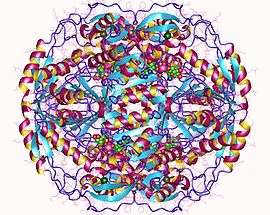Aldehyde dehydrogenase (NAD+)
| aldehyde dehydrogenase (NAD) | |||||||||
|---|---|---|---|---|---|---|---|---|---|
 Aldehyde dehydrogenase tetramer, Human | |||||||||
| Identifiers | |||||||||
| EC number | 1.2.1.3 | ||||||||
| CAS number | 9028-86-8 | ||||||||
| Databases | |||||||||
| IntEnz | IntEnz view | ||||||||
| BRENDA | BRENDA entry | ||||||||
| ExPASy | NiceZyme view | ||||||||
| KEGG | KEGG entry | ||||||||
| MetaCyc | metabolic pathway | ||||||||
| PRIAM | profile | ||||||||
| PDB structures | RCSB PDB PDBe PDBsum | ||||||||
| Gene Ontology | AmiGO / QuickGO | ||||||||
| |||||||||
In enzymology, an aldehyde dehydrogenase (NAD+) (EC 1.2.1.3) is an enzyme that catalyzes the chemical reaction
- an aldehyde + NAD+ + H2O an acid + NADH + H+
The 3 substrates of this enzyme are aldehyde, NAD+, and H2O, whereas its 3 products are acid, NADH, and H+.
This enzyme belongs to the family of oxidoreductases, specifically those acting on the aldehyde or oxo group of donor with NAD+ or NADP+ as acceptor. The systematic name of this enzyme class is aldehyde:NAD+ oxidoreductase. Other names in common use include CoA-independent aldehyde dehydrogenase, m-methylbenzaldehyde dehydrogenase, NAD-aldehyde dehydrogenase, NAD-dependent 4-hydroxynonenal dehydrogenase, NAD-dependent aldehyde dehydrogenase, NAD-linked aldehyde dehydrogenase, propionaldehyde dehydrogenase, and aldehyde dehydrogenase (NAD). This enzyme participates in 17 metabolic pathways: glycolysis / gluconeogenesis, ascorbate and aldarate metabolism, fatty acid metabolism, bile acid biosynthesis, urea cycle and metabolism of amino groups, valine, leucine and isoleucine degradation, lysine degradation, histidine metabolism, tryptophan metabolism, beta-alanine metabolism, glycerolipid metabolism, pyruvate metabolism, 1,2-dichloroethane degradation, propanoate metabolism, 3-chloroacrylic acid degradation, butanoate metabolism, and limonene and pinene degradation.
References
- Boyer PD, Lardy H, Myrback K, eds. (1963). The Enzymes. 7 (2nd ed.). New York: Academic Press. pp. 203–221.
- Racker E (February 1949). "Aldehyde dehydrogenase, a diphosphopyridine nucleotide-linked enzyme" (PDF). The Journal of Biological Chemistry. 177 (2): 883–92. PMID 18110463.
External links
- "Anti-ageing compound set for human trials after turning clock back for mice". The Guardian.
- Gomes AP, Price NL, Ling AJ, Moslehi JJ, Montgomery MK, Rajman L, White JP, Teodoro JS, Wrann CD, Hubbard BP, Mercken EM, Palmeira CM, de Cabo R, Rolo AP, Turner N, Bell EL, Sinclair DA (December 2013). "Declining NAD(+) induces a pseudohypoxic state disrupting nuclear-mitochondrial communication during aging". Cell. 155 (7): 1624–38. doi:10.1016/j.cell.2013.11.037. PMC 4076149. PMID 24360282.